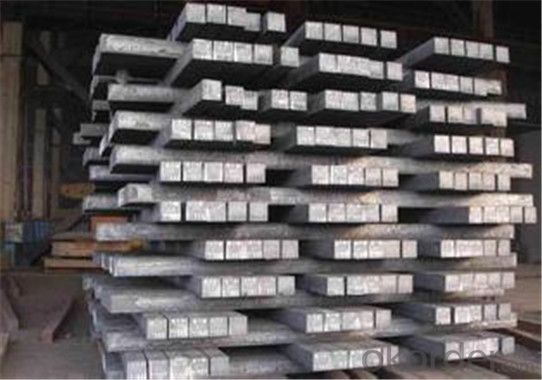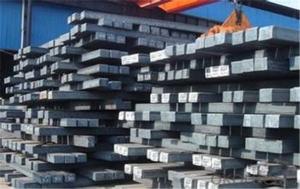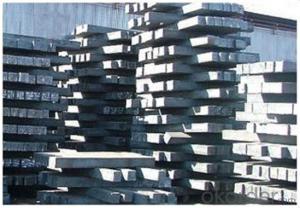Square Steel Billets Hot Sale Deformed Billet Q275/5SP in China
- Loading Port:
- Tianjin
- Payment Terms:
- TT OR LC
- Min Order Qty:
- 3000 m.t.
- Supply Capability:
- 45555555 m.t./month
OKorder Service Pledge
OKorder Financial Service
You Might Also Like
Item specifice
Description of steel billet:
We procure world class quality steel billets which meets the specific requirements of the clients
The Billets produced by the company can be broadly divided into three main types i.e.
1.M.S. Billets
2.CRS Billets
3.Special Alloy Billets
Festures of steel billet:
Billets are used for rolling of TMT Re-Bars of Fe415 and Fe500 Grade and various other structural steel products. Billets are used fro rolling of CRS TMT Re-Bars.
Special Alloy Billets are used for rolling of any special grade TMT Re-Bars like Earthquake resistant TMT Re-Bars and for special grade structural steel products.
Specifications of steel billet:
Type | Steel billet / Square steel/ Steel square bar |
Standard grade | 3SP/PS, 5SP/PS, Q195, Q235, Q255, Q275, 20MnSi etc. |
MOQ | 1000 MT |
Technique | Hot rolled |
Size | 50*50mm ~ 160*160mm |
Length | 3~12m |
Packing | Loose packing, in bundle |
Payment terms | T/T, L/C at sight, Usance L/C |
Trade terms | EXW, FOB, CFR, CIF |
Trans terms | FIO, FILO, FLT |
Inspection | Third party inspection accepted |
Delivery time | 15-30 days, according to the quantity |
Applications | carbon structural steel, wire rod, rod, deformed bars, profile steel, machine parts, and steel moulds etc . |
Note | Customized service is available (for sizes,length and chemical components etc.). |
Images of steel billet:

FAQ:
1. What is your package?
Packing situation: standard seaworthy packing or as customer required.
2. How long is the lead time?
Delivery time: 45 days after order confirmed.
3. What payment term do you accept?
Payment: T/T or L/C at sight.
- Q:What is the hardness range of steel wire rod?
- The hardness range of steel wire rod typically varies between 35 to 55 on the Rockwell C scale.
- Q:How is steel wire rod used in the manufacturing of wire for electrical cables?
- Steel wire rod is used in the manufacturing of wire for electrical cables as it serves as the base material for producing the wire. The steel wire rod is first drawn through a series of dies to reduce its diameter, resulting in a thinner wire. This wire is then coated with insulation material, such as PVC or nylon, to provide electrical insulation and protection. The steel wire rod's strength and durability make it an ideal choice for providing structural support to the electrical cables, ensuring their reliability and longevity.
- Q:What are the common production processes for meitnerium-coated steel wire rod?
- The common production processes for meitnerium-coated steel wire rod typically involve several steps. First, the steel wire rod is cleaned and prepared to remove any impurities or contaminants. Next, a thin layer of meitnerium is deposited onto the surface of the wire rod through a process called physical vapor deposition or chemical vapor deposition. This can be done in a controlled environment using specialized equipment. After the meitnerium coating is applied, the wire rod may undergo further treatments such as annealing or heat treatment to enhance its properties. Finally, the coated wire rod is inspected, tested, and packaged for distribution or further processing.
- Q:What are the common post-processing treatments for steel wire rod?
- Common post-processing treatments for steel wire rod include: 1. Pickling: This treatment involves immersing the wire rod in an acid solution to remove any scale or rust on the surface. Pickling helps to improve the wire rod's appearance and provides a clean surface for subsequent treatments. 2. Drawing: Wire rod is often passed through a series of dies to reduce its diameter and increase its length. This process, known as drawing, helps to refine the wire rod's structure, improve its mechanical properties, and achieve the desired dimensions. 3. Annealing: Annealing is a heat treatment process that involves heating the wire rod to a specific temperature and then slowly cooling it. This treatment helps to relieve internal stresses, improve the wire rod's ductility, and enhance its machinability. 4. Coating: Wire rod can be coated with various protective materials to enhance its corrosion resistance or provide specific properties. Common coating methods include galvanizing, where the wire rod is coated with a layer of zinc, and zinc-aluminum alloy coating, which offers even better corrosion protection. 5. Surface finishing: Wire rod can undergo various surface finishing treatments to enhance its appearance and improve its performance. These treatments may include polishing, grinding, or shot blasting to remove any surface imperfections, roughness, or contaminants. 6. Tempering: Tempering is a heat treatment process that involves reheating the wire rod to a specific temperature and then cooling it rapidly. This treatment helps to improve the wire rod's toughness and strength by reducing the hardness achieved during previous treatments. 7. Inspection and testing: After the post-processing treatments, wire rod undergoes inspection and testing procedures to ensure it meets the required specifications and quality standards. This may involve checking its dimensions, mechanical properties, surface condition, and conducting various tests such as tensile strength testing or hardness testing. These common post-processing treatments for steel wire rod are crucial for enhancing the wire rod's properties, improving its performance, and ensuring it meets the desired specifications for various applications in industries such as construction, automotive, and manufacturing.
- Q:What are the standard impact strength requirements for steel wire rod?
- The standard impact strength requirements for steel wire rod vary depending on the specific application and industry standards. However, in general, steel wire rods are expected to possess a high level of impact strength to withstand various loading conditions and prevent failure or deformation. These requirements typically include meeting specific impact energy values, as specified by relevant industry standards or customer specifications.
- Q:What are the different surface coating removal methods for steel wire rod?
- There are several surface coating removal methods for steel wire rods, including mechanical methods such as sanding or grinding, chemical methods like acid stripping or chemical solvents, and thermal methods like flame or heat treatment.
- Q:How is steel wire rod used in the production of wire products?
- Wire products rely heavily on steel wire rod as a vital component in their production. This semi-finished product is created through a rolling process from steel billets. It is widely used across different industries as a raw material to manufacture various types of wire products. The production of steel wires is one of the primary uses for steel wire rod. These wires find extensive applications in construction, automotive, electrical, and manufacturing sectors for diverse purposes. For instance, they are employed in reinforcing concrete structures, creating wire ropes, making fences, springs, nails, and screws. To manufacture wire products, steel wire rod undergoes a series of manufacturing processes. Initially, it is heated and then passed through rolling mills to decrease its diameter and increase its length. This process, referred to as hot rolling, enhances the mechanical properties of the wire rod. Following hot rolling, the wire rod is cooled and subjected to a pickling process to eliminate any scale or impurities from its surface. It is then drawn through dies to further reduce its diameter and improve its surface finish. This cold drawing process enhances the wire's strength and ductility. Once the desired size and properties are achieved, the wire can be further processed or supplied as a finished product. Depending on the requirements, additional processes such as heat treatment, coating, or surface finishing may be applied to enhance the wire's performance and make it suitable for specific applications. In conclusion, steel wire rod plays a critical role as a raw material in the production of wire products. Its versatility, strength, and ductility make it an optimal choice for a wide range of applications. Through various manufacturing processes, the wire rod is transformed into high-quality steel wires that find extensive use in construction, automotive, electrical, and manufacturing industries.
- Q:What are the common production processes for lead-coated steel wire rod?
- The common production processes for lead-coated steel wire rod typically involve steps such as wire rod cleaning, lead coating application, drying, and coiling. The wire rod is first cleaned to remove any impurities or contaminants. Then, a lead coating is applied to the wire rod using methods like hot-dipping or electroplating. After the coating is applied, the wire rod is dried to ensure it is fully cured and ready for use. Finally, the coated wire rod is coiled for storage or further processing.
- Q:What are the main factors affecting the market sales of steel wire rod?
- The main factors affecting the market sales of steel wire rod include the overall demand for steel products, economic conditions, industrial production and construction activity, global trade and competition, raw material availability and costs, technological advancements, and government policies and regulations.
- Q:What are the main factors affecting the recyclability of steel wire rod?
- The main factors affecting the recyclability of steel wire rod include the presence of contaminants, such as oils and coatings, which can affect the quality of the recycled product. The diameter and composition of the wire rod also play a role, as thinner and purer rods are generally easier to recycle. Additionally, the availability and efficiency of recycling technologies and infrastructure in a particular region can impact the recyclability of steel wire rod.
1. Manufacturer Overview |
|
|---|---|
| Location | |
| Year Established | |
| Annual Output Value | |
| Main Markets | |
| Company Certifications | |
2. Manufacturer Certificates |
|
|---|---|
| a) Certification Name | |
| Range | |
| Reference | |
| Validity Period | |
3. Manufacturer Capability |
|
|---|---|
| a)Trade Capacity | |
| Nearest Port | |
| Export Percentage | |
| No.of Employees in Trade Department | |
| Language Spoken: | |
| b)Factory Information | |
| Factory Size: | |
| No. of Production Lines | |
| Contract Manufacturing | |
| Product Price Range | |
Send your message to us
Square Steel Billets Hot Sale Deformed Billet Q275/5SP in China
- Loading Port:
- Tianjin
- Payment Terms:
- TT OR LC
- Min Order Qty:
- 3000 m.t.
- Supply Capability:
- 45555555 m.t./month
OKorder Service Pledge
OKorder Financial Service
Similar products
New products
Hot products
Related keywords




























